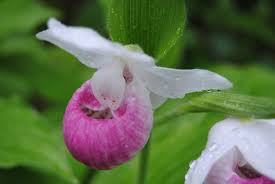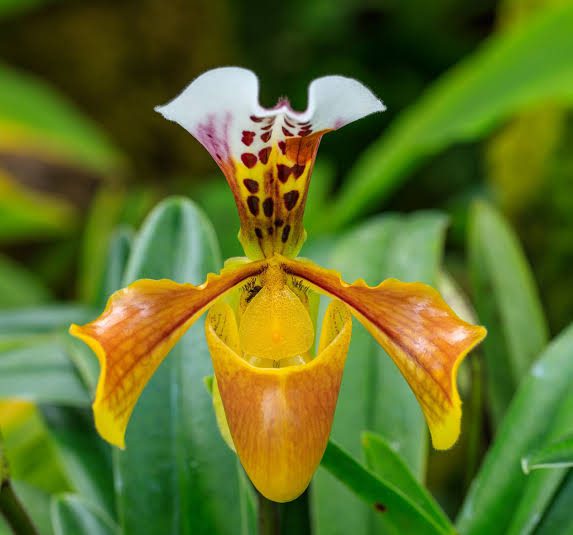Lady Slipper, a captivating and exquisite orchid, holds a special place in the world of flowers. With its unique and enchanting blooms, this extraordinary plant has long fascinated botanists, garden enthusiasts, and nature lovers alike. From its distinctive slipper-shaped pouch to its delicate petals and intricate patterns, the Lady Slipper stands as a testament to nature’s artistry and beauty.
Belonging to the subfamily Cypripedioideae within the Orchidaceae family, Lady Slippers encompass several species that grace diverse regions of the world. Among the most renowned varieties are the Pink Lady Slipper (Cypripedium acaule), the Yellow Lady Slipper (Cypripedium calceolus), and the Showy Lady Slipper (Cypripedium reginae). Each species possesses its own unique characteristics, adding to the allure of the Lady Slipper as a whole.
The Lady Slipper’s distinctive feature, from which it derives its name, is its pouch-shaped lip or labellum. This labellum is often larger and more elaborate than the other petals, forming a pouch that resembles a slipper or shoe. The pouch serves a remarkable purpose, not only as an aesthetic marvel but also as an integral part of the flower’s reproductive process.
The slipper-shaped pouch of the Lady Slipper plays a vital role in attracting and providing shelter for specific pollinators, such as bees, wasps, and sometimes even small insects. These insects enter the pouch to seek nectar, guided by enticing colors and patterns on the petals. Inside, they discover a maze of hairs and structures that prevent their easy exit, leading them to navigate around the flower’s reproductive organs. In this process, the insects inadvertently collect and transfer pollen, aiding in the orchid’s successful pollination and propagation.
Lady Slippers are often found in shaded woodland areas, thriving in rich, organic soils. They have evolved to be resilient and adapted to specific habitats. Some species prefer acidic soils, while others thrive in more alkaline environments. Their ability to adapt to different conditions has allowed them to inhabit diverse regions, including North America, Europe, and Asia.
Due to their beauty and uniqueness, Lady Slippers have become highly sought after by collectors and enthusiasts. However, their popularity has also made them vulnerable to habitat loss and overharvesting. Several species of Lady Slipper are now endangered or protected due to their dwindling populations. Conservation efforts and strict regulations have been put in place to preserve and protect these precious orchids for future generations.
For those fortunate enough to witness the blossoming of a Lady Slipper, it is a sight to behold. The intricate patterns and vibrant colors of its petals, combined with the graceful curvature of the slipper-shaped pouch, create a spectacle that is both mesmerizing and awe-inspiring. The Lady Slipper stands as a symbol of nature’s ingenuity and the remarkable diversity of plant life on our planet.
Additionally, the Lady Slipper is a true marvel of the botanical world. Its distinct beauty, coupled with its intricate reproductive mechanisms, showcases the brilliance of nature’s design. As we appreciate and admire these enchanting orchids, let us also strive to protect and preserve their habitats, ensuring that future generations can experience the wonder of the Lady Slipper for years to come.
History And Significance of Lady Slipper

The history and significance of the Lady Slipper orchid extend far beyond its captivating beauty. This remarkable flower holds cultural, historical, and botanical importance, making it a cherished symbol in various societies around the world.
Culturally, the Lady Slipper has often been associated with femininity, grace, and delicate beauty. Its elegant form and exquisite blooms have inspired artists, poets, and artisans throughout history. In many indigenous cultures, the Lady Slipper holds spiritual significance and is believed to possess healing properties. Native American tribes, such as the Ojibwa and Iroquois, held the Lady Slipper in high regard, utilizing it for medicinal purposes and considering it a sacred plant.
From a historical perspective, the Lady Slipper orchid has been the subject of exploration and fascination for botanists and naturalists. The discovery and documentation of various Lady Slipper species played a crucial role in expanding our understanding of orchids and their ecological relationships. Notable botanists like John Lindley, Carl Linnaeus, and Frederick Coville made significant contributions to the classification and study of Lady Slippers, advancing the field of botany.
Botanically, the Lady Slipper orchid is of great significance due to its unique reproductive adaptations. The slipper-shaped pouch, a defining characteristic of Lady Slippers, serves as a highly specialized structure for attracting and facilitating pollination by specific insects. The complex interaction between the orchid and its pollinators, often involving intricate behavior and precise movements, has intrigued scientists for centuries. The study of these interactions has provided valuable insights into plant-pollinator relationships and evolutionary biology.
Conservation efforts surrounding Lady Slippers highlight their significance in preserving biodiversity. Several species of Lady Slipper orchids are threatened or endangered due to habitat destruction, illegal collection, and environmental changes. Recognizing their ecological importance and cultural value, conservation organizations and botanical gardens worldwide work diligently to protect and restore Lady Slipper populations, ensuring their survival for future generations.
Furthermore, Lady Slippers have become highly prized and sought after by horticulturists and orchid enthusiasts. Many botanical gardens and specialized nurseries cultivate and propagate these orchids, both for scientific research and for the enjoyment of enthusiasts who appreciate their beauty and rarity. Breeding programs aimed at developing robust and sustainable cultivars help reduce the pressure on wild populations while providing opportunities for gardeners to grow and appreciate these exquisite flowers.
However, the Lady Slipper orchid holds a rich history and significant cultural, historical, and botanical importance. Its association with femininity, spiritual beliefs, and healing properties, along with its role in scientific exploration and conservation, has cemented its place as a revered and cherished flower. The Lady Slipper continues to captivate hearts and minds, reminding us of the wonders of nature and the need to protect and preserve our natural heritage.
Read Also: Options for Genetic Improvement in Tropical Livestock
Lady Slipper Orchid

Lady Slipper orchids (Cypripedioideae) are a captivating and distinctive group of orchids known for their unique and complex flowers. They belong to the subfamily Cypripedioideae within the Orchidaceae family. The name “Lady Slipper” comes from the shape of their slipper-like pouch, which serves as an alluring trap for pollinators and plays a critical role in their reproductive process.
The most striking characteristic of Lady Slipper orchids is their pouch-shaped labellum, or lip, which is often more substantial than the other petals. This pouch resembles a slipper or shoe, hence the name “Lady Slipper.” It serves as a landing platform and shelter for pollinating insects, guiding them toward the flower’s reproductive organs.
Lady Slippers have evolved a sophisticated reproductive strategy. Specific pollinators, such as bees, wasps, or flies, are attracted to the orchids by their coloration and scent. Once inside the pouch, the insects become temporarily trapped due to the slippery surface and specialized structures. As they attempt to exit, they come into contact with the flower’s pollen masses (pollinia), which then adhere to their bodies. Upon visiting another Lady Slipper flower, the pollinia are deposited, facilitating cross-pollination.
There are various species of Lady Slipper orchids found around the world, each with its distinct characteristics and geographic distribution. Some well-known species include Cypripedium acaule (Pink Lady Slipper), Cypripedium calceolus (Yellow Lady Slipper), and Cypripedium reginae (Showy Lady Slipper).
Lady Slipper orchids are primarily found in temperate regions, often in woodland habitats with acidic and humus-rich soils. They are distributed across different continents, including North America, Europe, and Asia.
Several species of Lady Slipper orchids are considered rare or endangered due to habitat loss, over-harvesting, and other human impacts. Consequently, many countries have enacted protective measures to preserve these beautiful flowers in their natural environments.
Growing Lady Slipper orchids can be challenging, and they are best suited for experienced orchid growers. Proper light conditions, humidity, and suitable potting media are essential for their successful cultivation. Reproduction through seeds can be a slow and delicate process, but specialized nurseries may offer cultivated plants for purchase.
In addition, Lady Slipper orchids are captivating and remarkable plants, admired for their unique slipper-shaped pouches and complex reproductive strategies. These enchanting flowers hold cultural significance and are cherished by orchid enthusiasts and nature lovers worldwide. While they require specific care and attention, the beauty and allure of Lady Slipper orchids make them a treasure to behold for those willing to take on the rewarding challenge of growing them.
Read Also: All About Hamsters as Good Pets
Lady Slipper Flower

The Lady Slipper flower, also known as the Lady’s Slipper, is a type of orchid that belongs to the subfamily Cypripedioideae within the Orchidaceae family. It is well-known for its unique and distinctive slipper-shaped pouch, which gives the flower its common name. The Lady Slipper orchid is one of the most captivating and cherished flowers in the world of horticulture and botany.
Key features of The Lady Slipper Flower
1. Slipper-Shaped Pouch: The defining characteristic of the Lady Slipper flower is its pouch-shaped lip or labellum. This pouch, which resembles a slipper or shoe, is often more prominent and elaborate than the other petals. It serves as a specialized structure to attract and trap specific pollinators, playing a crucial role in the flower’s reproductive process.
2. Diversity of Species: The Lady Slipper orchid encompasses several species with distinct characteristics, colors, and geographic distributions. Some well-known species include the Pink Lady Slipper (Cypripedium acaule), Yellow Lady Slipper (Cypripedium calceolus), and Showy Lady Slipper (Cypripedium reginae).
3. Reproductive Mechanism: Lady Slipper flowers have evolved a fascinating reproductive strategy. They attract specific pollinators, such as bees, wasps, or flies, through their coloration, patterns, and scent. Once the pollinators enter the pouch in search of nectar, they become temporarily trapped due to the slippery surface and intricate structures. As the insects attempt to escape, they come into contact with the flower’s pollinia, which then adhere to their bodies. When they visit another Lady Slipper flower, the pollinia are transferred, facilitating cross-pollination.
4. Habitat and Distribution: Lady Slipper flowers are often found in woodland habitats, growing in moist, acidic soils rich in organic matter. They are distributed across various regions, including North America, Europe, and Asia.
5. Conservation Status: Some species of Lady Slipper orchids are classified as rare, threatened, or endangered due to habitat loss, over-collection, and environmental changes. As a result, these flowers are protected by law in many countries to preserve their populations.
6. Significance and Beauty: The Lady Slipper flower holds cultural significance in different societies and has been admired and cherished for centuries for its elegance, grace, and unique appearance. Its enchanting beauty and rarity make it a sought-after and treasured addition to both natural habitats and cultivated gardens.
However, the Lady Slipper flower stands as a symbol of nature’s creativity and complexity, captivating the hearts of botanists, horticulturists, and nature enthusiasts alike. Their unique shape, remarkable reproductive mechanisms, and diverse species contribute to their allure and continued fascination across the globe.
Read Also: Strategies for Reducing Water Pollution
